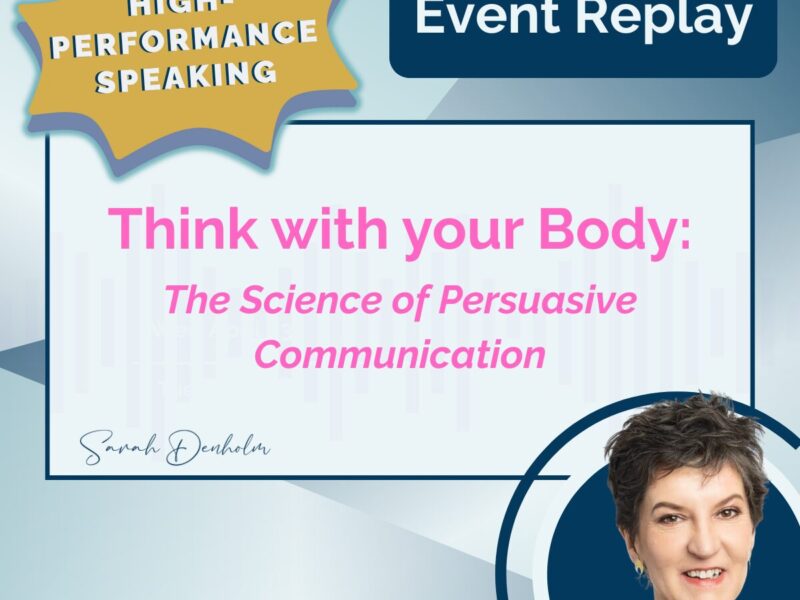Have you made a New Year’s resolution to finally succeed with your public speaking goals?
Have you decided, finally, to overcome your fear of public speaking, or become a better presenter? I assume that you’re interested in the topic, or you wouldn’t be reading this article! But have you come up with anything specific to work on? Or are you in for another year of avoidance, despite your best intentions?
We usually have a sense of clearing out, of optimism and openness to new desires and goals as each new year rolls around. But we’re not so good at making them stick. Today I’m going to suggest three ways to pin down your resolutions so that they’re much more likely to happen. You can succeed with your public speaking goals this year.

My over-arching suggestion is: don’t set resolutions. Instead, create a vision for your year of public speaking by becoming clear on how you want to feel and what you want to have – before you decide what you need to do.
The way we structure our resolutions and what we choose to focus on, makes the difference between them not happening, being a major struggle, or success. One problem is that when we focus on something that’s not tangible enough – like “become a better speaker” or “overcome my fear of public speaking” – there’s not enough impact or detail to move us forward.
So we need to flesh it out. Here’s how:
1. How do you want to feel?
Instead of focusing on what you need to do (when overwhelm, inertia or panic can easily set in), focus on how you want to feel about your public speaking in the future. And I really want you to think about what you really want – even if you don’t think it’s possible. This is vital: don’t limit yourself at this point.
As an example, I frequently have clients who tell me “I just want to enjoy my public speaking…not to dread it any more, but to enjoy presenting”. If that’s you, say it – even if you don’t believe it. Own it by stating:
“This year I want to enjoy my public speaking.”
You could add to it:
“This year I want to enjoy my public speaking. I want my voice to be heard, finally – I’m tired of hiding. And to feel more competent and comfortable. To feel the relief of not spending days of my life fretting and worrying about my next presentation.”
Ok, your turn now. How about coming up with this vision right now? Think about it, say it out loud or write it down….
I waited. Hope you’ve done it! Great start. Now let’s look at what you want to have.
2. What do you want to have?
This is the more detailed, tangible part where you add to the first part’s ‘feeling’ vision.
Examples:
- “I want to speak up in meetings without feeling sick”
- “I want to finish my presentation at least 24 hours ahead of time, and not be tweaking and fretting with slides or content until the last minute, completely stressing myself out”
- “I want to be able to eat breakfast on the morning of my presentation”
- “I want to be able to sleep the night before I have to deliver to the board”
- “I want to start working on my presentation from the time I know I’ll be speaking, rather than avoiding it desperately until the 11th hour, when it’s too late, and I feel out of control”
- “I want to really engage my audience, keep their attention, and have a single clear message for them to take away (not four messages because they’re all important and I couldn’t choose)”
You get the idea. You might want to stop again, think about this and perhaps write a couple of statements down
3. Making it happen
Here’s how I suggest you make this work: by setting up rules for yourself. I know from bitter experience that if I don’t set up specific rules and parameters, I tend to fall away into driftland. One way I’ve found that really works is to use ‘when-then’ planning, which spells out exactly what you’ll do when the situation arises. It’s a variation on ‘If-Then’ planning, which you may have heard of. (If you’re interested, Google it: there’s information on studies showing that it works here.)
The concept is simple: “When A. happens, then I’ll do B.” It works because it sets up clarity and control: our brains love both.
Examples:
- “When I’m told by my boss that I have to give a presentation next week, then I’m going to immediately clear a space in my diary, switch off all other distractions and spend thirty minutes working on it”
- “When I enter the presentation space, then I’ll use the door-frame/front row as a trigger to hold to my head high, breathe low, and walk purposefully up to the front”
- When I’m in the weekly sales meeting and my boss calls for comments from the group, then I’m going to give my opinion at least once in every three meetings”
- When I hear my internal negative self-talk expressing self-doubt or criticism, then I’m going to thank it for sharing, and replace it with a more hopeful, positive statement”
- When I drive to work, then instead of listening to the radio I’ll think through parts of my speech, or practise the opening out loud”
When you start to do this planning consistently, it makes the likelihood of achieving what you want so much greater.
Finally, pitfalls to remember:
- You will hit resistance. We have different voices inside our heads with different agendas for us. One voice may want you to succeed with your speaking goals, while another thinks it’s not safe, and a really bad idea. These voices will argue. The key is to be aware of them and move forwards with your plans anyway
- You may need to change your environment. As an example: if I can’t get going with a piece of work I need to do, I leave my desk and move somewhere else in the house, or even sit in front of the TV to trick my mind into thinking it’s not in work mode. Then once my ideas are flowing and I’m motivated, I turn the TV down or off
- Focus on improving one element at a time. When one’s locked-in and automatic, meaning that you don’t have to focus deliberately on it each time, it’s much easier to get another one rolling. And the time needed to lock it in? Anywhere between 30 – 90 days. The old ’21 days to a new habit’ paradigm is sadly not proven to work
- When you falter or stop – and you will – just start again. You’ll get there!
And getting outside support or accountability is also a major way to succeed with your public speaking goals. Get some help if you need it, from me or others. If you’re in, or close to, Melbourne, I offer different course options (Complete Presentation Skills) here , and there’s also one-on-one face to face or Skype video coaching globally here.
Best wishes with your public speaking goals this year!




